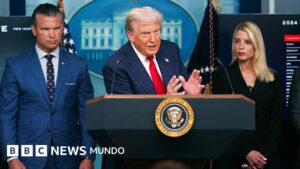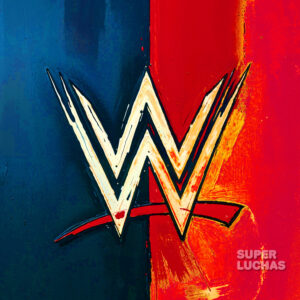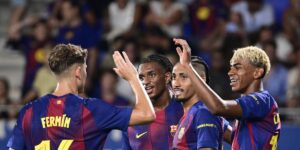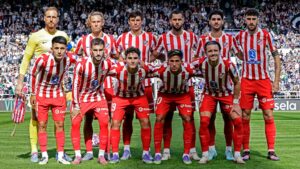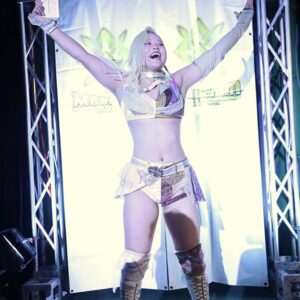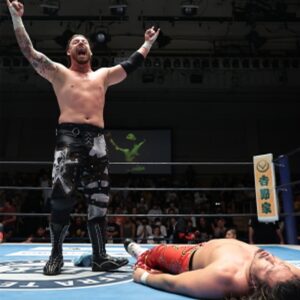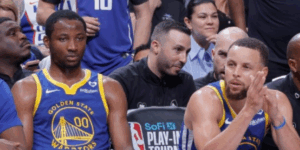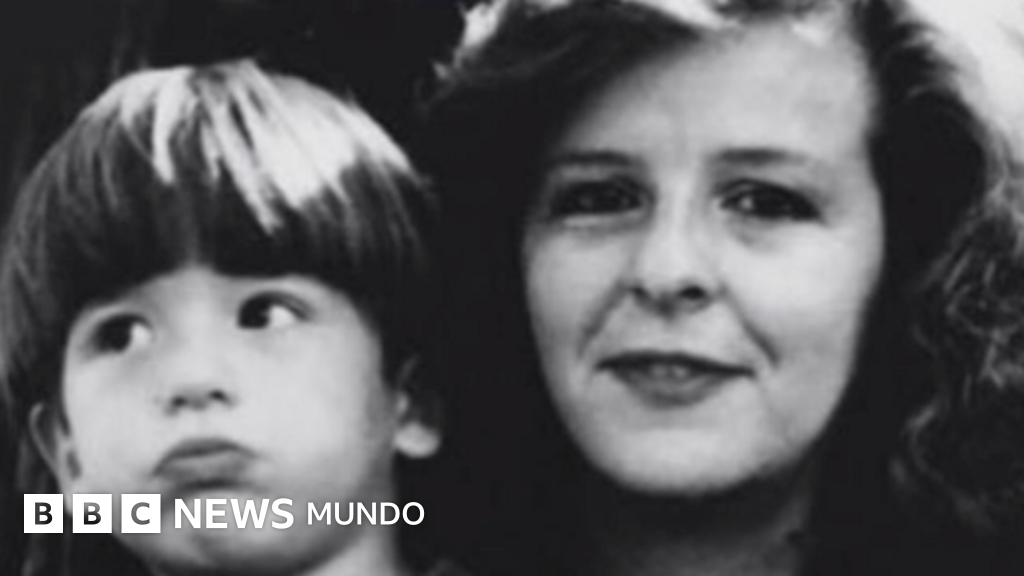
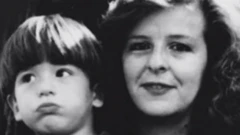
Image source, Miguel Uribay Instagram
-
- Author, Andrea Díaz Cardona
- Author's title, BBC News World
Three decades later, violence in Colombia repeats the same tragedy. And in the same family.
It was January 1991, when after several months of kidnapping the outstanding journalist Diana Turbay, 40 years old and daughter of former president Julio Cesar Turbay, was killed in a controversial rescue attempt.
His youngest son, Miguel Uribe Turbay, was close to turning 5.
34 years later Miguel, turned into a politician with a lawyer and mastery in public policies who had managed to work in the Mayor's Office of Bogotá, to be a councilor of that city and, more recently, Senator of the Republic, was emerging as one of the favorite candidates for the next presidential elections.
Until on June 7 he was brutally shot in a public event of his campaign and in the street.
The news of his attack, as at the time of his mother's kidnapping, monopolized press holders and generated outrage in the country.
The authorities initiated the investigation to find those responsible. Six people were arrested as suspicious, including a 15 -year -old teenager, accused of being the material author of the shots.
In the early hours of this Monday, August 11 and after more than two months in intensive care, Miguel Uribe Turbay died at 39, almost at the same age that Diana died, her mother.
His only son, Alejandro, is also close to 5 years.
BBC Mundo reconstructs the history of the Turbay family that, like many other Colombian families, has been the victim of systematic violence that has left millions of orphaned children.
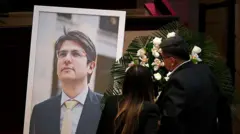
Image source, Raul Arboleda/AFP via Getty Images
The origin of Diana and Miguel
Diana Turbay Quintero's parents were relevant personalities in Colombia's recent history.
Julio Cesar Turbay Ayala, his father, was president between 1978 and 1982. Lebanese descent and a member of the Liberal Party, held several diplomatic positions.
Nydia Quintero, her mother, dedicated her life to social work and philanthropy. He created the Solidarity Foundation for Colombia with which he institutionalized an annual walk that seeks to collect funds for social works.
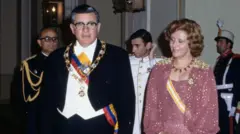
Image source, UPI/Bettmann Archive/Getty Images
Diana was born in 1950, was the oldest of four brothers with whom she grew up in Bogotá. Although she studied law, she did not exercise as a lawyer and instead forged a successful career as a journalist.
From her first marriage, María Carolina Hoyos Turbay was born, in 1972, who also dedicated himself to journalism and the public function in the communications area.
And from his second marriage, with businessman Miguel Uribe Lodoño, his son Miguel Uribe Turbay was born in 1986.
Miguel could only share his first years of life with his mother, “I have met my mother from the stories of other people, especially my family,” he said in a documentary about the story of Diana published nine years ago.
The last time he saw her, it was in the morning that she went on an alleged work trip that turned out to be a trap and resulted in kidnapping.
“I am very clear about the last day I saw her, the last hug and the kiss before he left. If for an adult death is difficult to understand, for a child is worse,” said Miguel Uribe in an interview for Bocas magazine in 2021.
Diana's tragedy
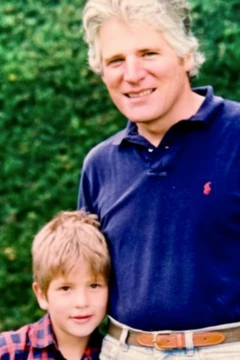
Image source, Miguel Uribay Instagram
In full 80s and the beginning of the 90 Diana Turbay Quintero was a recognized journalist in Colombia, while drug trafficking was booming and expanding guerrillas.
She worked as director of an independent magazine and a television news when she had to register, in a period of eight months, the murder of three presidential candidates: Carlos Galán, Bernardo Jaramillo and Carlos Pizarro.
His son Miguel is the fourth candidate for the presidency killed in the recent history of the country.
In this context of excessive violence, Diana Turbay received a proposal to interview Alias Cura Perez, who was the leader of the National Liberation Army, Eln, because there was talk of certain approaches and attempts to dialogue between that guerrillas and the government of that time.
“I believe that my mother always dreamed of the peace of Colombia (…) and as from journalism I could contribute a grain of sand …” said María Carolina in the documentary about Diana's life.
Diana accepted the interview, traveled with a group of colleagues to the jungle for the alleged meeting, but turned out to be a trap that tended the so -called group of extraditables, made up of several drug traffickers among which Pablo Escobar was.
The capos kidnapped several personalities to press the government and not to accept extraditing them, because they said they prefer a tomb in Colombia to a cell in a United States prison.
Diana Turbay was the first victim of that macabre strategy. She was kidnapped for five months on a farm in Antioquia, until in a rescue attempt by the authorities she was seriously injured.
As reported by the local press, Diana and her fellow cameraman tried to flee when she heard the overview of a helicopter, but her captors had the order not to let her be rescued alive. On January 25, 1991 and despite having arrived alive at the nearest hospital, Diana died, after receiving several bullet impacts.
18 years later, in 2009, the crime was declared a crime against humanity.
The forgiveness of Miguel and his family
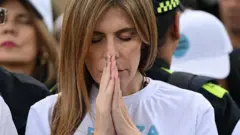
Image source, Luis Acosta/AFP via Getty Images
“I remember that we went to her in the council of Bogotá, paradoxically, in the same room where I met as councilor and president of the council 20 years later. And after that I remember being in the cemetery burying it. I do not remember, for example, the Mass or the chapel,” Miguel said in the 2021 interview.
And Colombia witnessed what it recounts. In the news, the images of the coffin lined with the tricolor flag and accompanied by a crowd headed by Diana's parents, her daughter María Carolina, who was 18 years old, and the then little Miguel – dressed with a white shirt with dark stripes – who took in one hand to his father and in the other to his sister.
25 years after that painful farewell, in October 2015, María Carolina met Jhon Jairo Velásquez Vásquez, aka Popeye, the only survivor of the Medellín poster who was involved in her mother's kidnapping.
In the emotional meeting that was registered by News Caracol, Pablo Escobar's hitman confirmed sharply that Diana “was a vehicle to knock out extradition, press the president and use his grandfather Mr. Turbay.” He also said that the order had been to kill her if extradition did not fall.
Popeye said that he had seen Miguel Uribe on television, who already had a public life for his political exercise and that “he looked a good person.”
María Carolina, in tears, replied: “When you kidnapped my mother I was 17 years old and he (Miguel) had three (there were really four) and has been very hard, but we forgive him. We forgive him and my little brother too.”
Six years after that meeting Miguel talked about his own process of forgiveness in an interview.
“I forgave all those who were involved, including Popeye and company. First, I understood that it had already happened, that nothing I did would return my mother, and instead forgive if I was going to enrich me as a person and allowed me to live without a burden”
And he referred to María Carolina: “My sister has a phrase that since I heard her, I have her present and it is:” When my mother dies, one asks why? But the question to ask is for what? “That is the question that helped me find path and meaning in life.”
Miguel Uribe reiterated several times that his mother was an example and his main motivation to continue in his political proposal.
The tragedy that is repeated
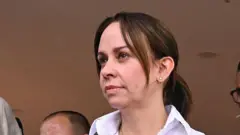
Image source, Luis Acosta/AFP via Getty Images
Doña Nydia Quintero, as she was known in Colombia, had to bury her daughter when she was already 58 years old, her 92 was admitted to the same clinic where her grandson was in intensive care.
He died on June 30 for complications of his age and without knowing the outcome of Miguel's story.
“Thank you for being my mother of life, my refuge when I lost mine,” María Carolina wrote in her networks when she fired her grandmother.
Meanwhile María Claudia Tarazona, Miguel's wife, publicly shared the advances of medical treatment that kept him alive, as well as some details of his family environment.
Miguel and María Claudia had been together with the three daughters of her for 14 years – their first marriage – and with Alexander, their son.
In the only interview that has given a local media, María Claudia told on July 15 that he was with Miguel on the day of the attack and that he accompanied him in the ambulance to the clinic.
On the main suspect of the crime against her husband, she said that “the problem is what kind of society we are and what kind of country we are and how we normalize that 14 -year -old children are instruments for war.”
He thanked all the support he has received from people in the midst of the tragedy and said he promised Miguel to be well so that his children are well.
Just as Miguel's father became his mother and dad to get him ahead when he was five years old, today is María Claudia who faces that complex task after this new family tragedy.
“I know if Miguel was here I would be telling me (…) I need you to be with Alejandro,” he said in the interview.
After knowing the news of Miguel's death, María Claudia published an emotional message on her social networks: “Rest in peace love of my life, I will take care of our children”, to which María Carolina joined: “I am sure that our mother, who loves you so much, receives you today with open arms. Mommy … Our grandmother, our mother of life, is also waiting for you with infinite tenderness.”

Subscribe here To our new newsletter to receive every Friday a selection of our best content of the week.
And remember that you can receive notifications in our app. Download the latest version and act.

